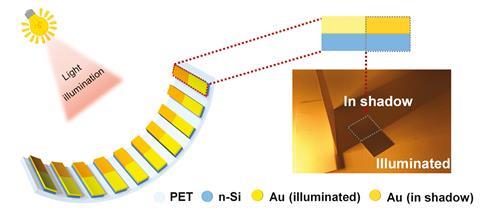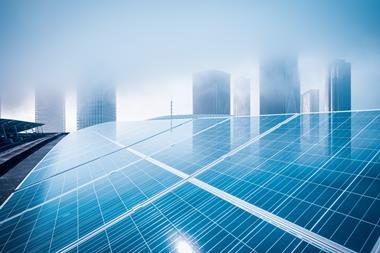Scientists have invented a device that can harvest energy from shadows. It could be used to generate energy in places where solar cells are ineffective, including inside the home or office.
Shadows are everywhere, and this is a problem for the solar energy industry. On solar farms, panels are spaced and inclined to receive maximum sunlight and to prevent one panel from shading another. This limits the amount of power that can be generated in an area. Solar cell efficiencies also degrade significantly under indoor illumination where shadows are commonplace.
Now, Swee Ching Tan and colleagues from the National University of Singapore have developed a simple device that can harvest energy when considerably shaded. ‘To make this device is much cheaper and easier than silicon solar cells,’ says Tan. ‘[Our device] only needs a piece of silicon substrate coated with a thin piece of [gold] metal film.’ It could be used to boost power generation on solar farms, as well as indoors, as the device is sensitive to shadows cast even by low light intensities. Tan says that the shadows cast by a dining room table, for example, could be used to charge a mobile phone.
The team showed that optical illumination contrasts create work function contrasts on metal films coated on a semiconductor, in this case silicon. Tan explains that due to this work function contrast ‘electrons can flow from the light region into the dark region as they are being generated in the silicon substrate’. Connecting this generator with an external circuit converts the flow of electrons into electrical power.

Experiments showed that the device is sensitive to where the electrodes sit in relation to the shadow edge and the transparency of the metal film. In 50% shadow it can generate a power density of 0.14μW/cm2 under indoor conditions (0.001 sun illumination), twice that of a commercial silicon solar cell.
However, photovoltaic expert Anita Ho-Baillie from the University of Sydney in Australia urges caution when making these comparisons. ‘Commercial silicon cells are not designed for shadows. They are designed to produce respectable current to power appliances and charge batteries. We are talking about kilowatts here,’ she says. ’The efficiency [of the shadow effect generator] is actually really low – 0.14μW/cm2 under 0.001Sun corresponds to a 0.14% power conversion efficiency.’
’We do understand that commercial silicon cells are not designed for shadows,’ responds Tan. ’We have developed this unprecedented concept of energy harvesting from shadows keeping in mind the fact that this unique piece of work could aid in an efficient energy generation in places where solar cells are ineffective. The comparison with commercial solar cells is restricted to an indoor space with persistent shadows. Yes, the efficiency of our current device is low. But the concept presented is novel and it would be a stepping stone for further experimentation in this domain of energy harvesting. The first device is always not the best device. There is scope for improvisation everywhere; especially in the field of photovoltaics, the commercial solar cells available today took years to optimise, perfect and mature.’ Ultimately, Tan wants to inspire others to think about shadows as an untapped energy source rather than a problem.
References
This article is free to access until 15 June 2020
Q Zhang et al, Energy Environ. Sci., 2020, DOI: 10.1039/d0ee00825g












No comments yet